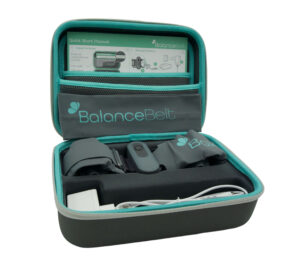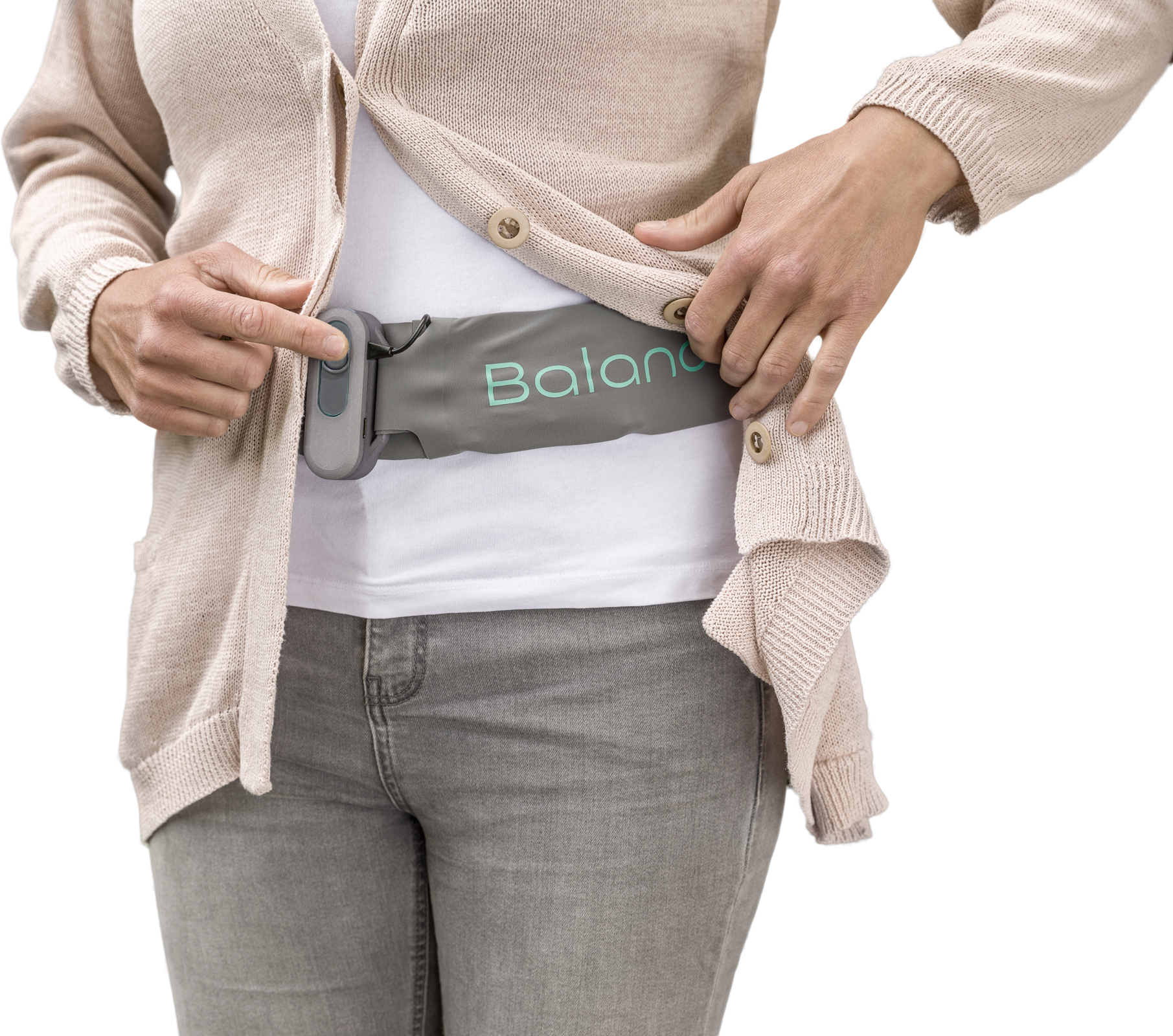The BalanceBelt is a smart, lightweight medical device designed for people with severe balance disorders such as Bilateral Vestibular Loss (BVL) or PPPD. It provides real-time feedback that helps patients walk more steadily, without relying on a cane, walker or other mobility aids. Supported by clinical research and now available through the HTE Framework agreement to all NHS Trusts in the UK, enabling access and prescription. The BalanceBelt offers a definitive treatment method managing complex vestibular disorders.



A growing and under-diagnosed condition
An estimated 290,000 people in the UK live with chronic vestibular conditions such as Bilateral Vestibular Hypofunction (BVH), Unilateral Vestibular Loss (UVL), and PPPD. These patients often struggle with:
- Poor postural control and increased fall risk
- Fatigue and cognitive overload
- Loss of independence in daily life
- Quality of life
For many, vestibular rehabilitation alone is not enough sufficient:
→ Up to 66% of BVH patients continue to struggle post-treatment
→ UVL patients see limited benefit in up to 30% of cases
→ 31x increased risk of falls due to multi-sensory impairment
The BalanceBelt
A new innovative treatment methods for Your Clinic and Patients
The BalanceBelt is a smart, wearable belt that delivers real-time vibrotactile feedback based on the wearer’s body movement and tilt. This feedback is interpreted subconsciously, enabling safer, more stable movement.
- Clinically proven: Mobility & Balance Score improves from 4.2 to 7.9*
- 73% long-term adherence, even in complex cases*
- Non-invasive, drug-free, and discreet—easy to integrate into daily life

What It Means for Your Patients
Improved Stability and Mobility
-
Real-time feedback helps patients maintain balance when walking or standing
-
Reduces risk of falling in challenging conditions (stairs, crowds, in the dark)
Greater Confidence and Independence
-
Enables patients to move more freely without reliance on canes or carers
-
Improves psychological wellbeing, reduces fear of falling
Enhanced Quality of Life
-
Less cognitive fatigue from “conscious balancing”
-
Patients return to hobbies, daily routines, even work
What It Means for You as a Professional
Offer Better Outcomes to Complex Patients
Reduces waiting lists as patients with a belt can possibly be discharged
Attainable treatment option for those not responding well to traditional vestibular rehabilitation
Evidenced-based, measurable outcomes you can track across assessments
Enhance Your Clinical Toolkit
A novel yet practical tool to complement your vestibular rehab protocols
Supports holistic, patient-centred care—physical, cognitive, and emotional
Position Yourself as an Innovator
Be among the forward-thinking professionals offering this cutting-edge solution
Available through an NHS-supported purchasing route—no additional system pressure
Who developed the BalanceBelt?


Currently Part of Major European Research Initiatives
The BalanceBelt is also included in several major ongoing clinical research efforts:
-
Multi-centre study in Denmark: focused on diagnostic and treatment protocols for BVL patients
-
Karolinska Institute (Sweden): Public study investigating treatment pathways for vestibular loss within the national health system
-
Pan-European PROVIDE Doctoral Network: Involving 10 PhD researchers across the EU (NL, BE, FR, SP, DE, AT), focused on diagnostic innovation, cost-benefit modelling, and wider access to care
The BalanceBelt is not only easy to introduce into clinical practice—it represents the next step in effective, measurable treatment for a complex, underserved patient group.
Backed by Peer-Reviewed Research
The BalanceBelt’s effectiveness is supported by multiple independent studies:
-
Kingma et al. (Journal of Neurology, 2019)
→ Average Mobility and Balance Score improved from 4.2 to 7.9
→ 23 out of 31 participants reported improvements between 60% and 200%
→ 5 participants resumed cycling after long periods of inactivity -
vd Berg et al. (2024, Prospective Open Study)
→ Showed sustained improvements in mobility and balance with subconscious vibrotactile stimulation
→ Confirmed long-term adherence and significant reduction in fall risk
FAQ
Where can I get more information about availability?
Please contact us and let us know your question and contact details. We will get back to you as soon as possible.
Has BalanceBelt been approved according to the EU Medical Device Regulations?
Yes. We can send you the declaration on conformity if you use contact us and let us know your question and contact details. We will get back to you as soon as possible.
Where can I obtain more clinical data on the BalanceBelt?
Please contact us and let us know your specific area(s) of interest and contact details. We will get back to you as soon as possible.
What clinical evidence supports the BalanceBelt?
Peer-reviewed studies show:
-
Significant improvement in Mobility and Balance Score (from 4.2 to 7.9)
-
Up to 200% improvement in stability for some patients
-
92% long-term adherence rate
See Kingma et al. (Journal of Neurology, 2019) and vd Berg et al. (2024, Prospective Open Study) for full clinical data.
What does it cost to prescribe or trial the BalanceBelt?
Costs may vary depending on funding routes. Please contact us directly at info@balancebelt.net or via HealthTrust Europe Customer Care to discuss pricing and contracting options.
Can I try the BalanceBelt with a patient?
Yes. A two-week home trial is built into the clinical protocol. Please reach out to arrange a trial or to speak with a member of our clinical support team.
Where can I find the recommended protocol for specialists?
See BalanceBelt Protocol Professionals for Specialists. If you have any questions about the protocol or the best way to conduct the trial session, contact us!